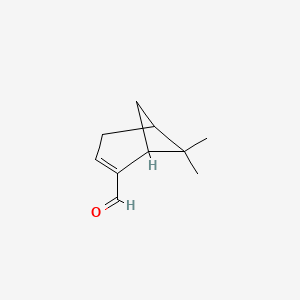| Authors | Title | Published | Journal | PubMed Link |
|---|---|---|---|---|
| Corin K et al. | Insertion of T4-lysozyme (T4L) can be a useful tool for studying olfactory-related GPCRs. | 2012 | Mol Biosyst | pmid:22491779 |
| Babu LH et al. | Myrtenal, a natural monoterpene, down-regulates TNF-α expression and suppresses carcinogen-induced hepatocellular carcinoma in rats. | 2012 | Mol. Cell. Biochem. | pmid:22763672 |
| Lin GS et al. | Synthesis and Antifungal Activity of Novel Myrtenal-Based 4-Methyl-1,2,4-triazole-thioethers. | 2017 | Molecules | pmid:28125042 |
| Goretti M et al. | Production of flavours and fragrances via bioreduction of (4R)-(-)-carvone and (1R)-(-)-myrtenal by non-conventional yeast whole-cells. | 2013 | Molecules | pmid:23681058 |
| Southwell IA | 25 years of natural product R&D with New South Wales agriculture. | 2005 | Molecules | pmid:18007515 |
| Zepeda LG et al. | Myrtenal, a controversial molecule for the proper application of the CIP Sequence Rule for multiple bonds. | 2011 | Nat Prod Commun | pmid:21560753 |
| Pareek A et al. | Feverfew (Tanacetum parthenium L.): A systematic review. | 2011 | Pharmacogn Rev | pmid:22096324 |
| Burgueño-Tapia E et al. | Absolute configuration of (-)-myrtenal by vibrational circular dichroism. | 2010 | Phytochemistry | pmid:20457457 |
| Lu M et al. | Cross-attraction between an exotic and a native pine bark beetle: a novel invasion mechanism? | 2007 | PLoS ONE | pmid:18074026 |
| Corin K et al. | Structure and function analyses of the purified GPCR human vomeronasal type 1 receptor 1. | 2011 | Sci Rep | pmid:22355687 |
Myrtenal
Myrtenal is a lipid of Prenol Lipids (PR) class. The related lipids are Pinene.
Cross Reference
Introduction
To understand associated biological information of Myrtenal, we collected biological information of abnormalities, associated pathways, cellular/molecular locations, biological functions, related genes/proteins, lipids and common seen animal/experimental models with organized paragraphs from literatures.
What diseases are associated with Myrtenal?
There are no associated biomedical information in the current reference collection.
No disease MeSH terms mapped to the current reference collection.
PubChem Associated disorders and diseases
What pathways are associated with Myrtenal
There are no associated biomedical information in the current reference collection.
PubChem Biomolecular Interactions and Pathways
Link to PubChem Biomolecular Interactions and PathwaysWhat cellular locations are associated with Myrtenal?
There are no associated biomedical information in the current reference collection.
What functions are associated with Myrtenal?
There are no associated biomedical information in the current reference collection.
What lipids are associated with Myrtenal?
Related references are published most in these journals:
| Lipid concept | Cross reference | Weighted score | Related literatures |
|---|
What genes are associated with Myrtenal?
There are no associated biomedical information in the current reference collection.
What common seen animal models are associated with Myrtenal?
There are no associated biomedical information in the current reference collection.
